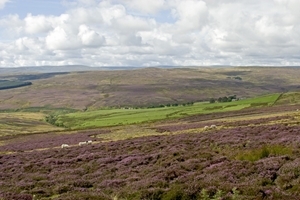By Henrietta Appleton, Policy Officer England
 I recently read Jeff Knott’s blog on the RSPB website – “There’s something very special about the uplands” – and I couldn’t agree more with the title. But on reading the rest of the blog, I felt obliged to respond. Not to reinforce the ‘contested landscape’ notion but to ask for a bit more tolerance. Just because you might not agree with someone’s viewpoint it doesn’t mean they are wrong, and you are right.
I recently read Jeff Knott’s blog on the RSPB website – “There’s something very special about the uplands” – and I couldn’t agree more with the title. But on reading the rest of the blog, I felt obliged to respond. Not to reinforce the ‘contested landscape’ notion but to ask for a bit more tolerance. Just because you might not agree with someone’s viewpoint it doesn’t mean they are wrong, and you are right.
When I visited the Peak District recently instead of the “treeless, lunar landscapes” “full of red grouse, notable sightings of golden plover and curlew, but not much else” I saw an almost unique landscape shaped by a multitude of human, industrial and climatic influences, not just land management practices, that is internationally protected. I saw the red grouse, golden plover and curlew to which Jeff refers; but I also saw a plethora of other wildlife from meadow pipits and wheatears to oystercatchers and ring ouzel – the last a first for me. I saw wooded cloughs (with a number of flitting LBJs (little brown jobs!) that I couldn’t identify), acid grassland inbye with lapwing actively seeking nest sites and the open moorland habitat mosaic that epitomises the wildness these places evoke.
Jeff’s and my interpretation of what we saw are arguably influenced by our opinion of grouse moor management. Having co-written the GWCT’s audit of grouse moor management’s contribution to the government’s 25-year environment targets, I believe that grouse moor management has a role to play in addressing our climate and nature emergencies. Without the management undertaken by grouse moor managers and keepers, the golden plover and curlew to which Jeff refers would almost certainly be lost – as evidenced by the declines in the Berwyn Mountains that we wrote about recently – and the area of heather moorland would decline – in contravention of international conservation obligations. An often-overlooked aspect of the focus on peatlands. However, having recently visited the RSPB’s Lake Vyrnwy estate and discussed the management practices they are employing there, I am also clear that we are all trying to achieve the same thing: nature recovery.
So are the opponents of grouse shooting suffering from the psychological phenomenon known as ‘focusing illusion’? This concept suggests that by focusing on one effect of a change (a reduction in illegal raptor killing?) there is a tendency to diminish perception of all the other possible effects of that change (the loss of heather moorland, a change in the wildlife assemblage (biodiversity), loss of jobs, privately funded peatland restoration and protection from wildfire etc). I fear that such an approach is resulting in policies that ultimately will diminish our uplands.
So instead of invoking further the ‘contested landscape’ notion, should not conservationists look to the one priority that we can all agree to: it is imperative we reverse the decline in our wildlife. If we agree on that, then we need also to agree to adapt our approaches to species or family group conservation based on the best available science.
And if we did that, then the RSPB’s work at Hope Farm on wildlife-friendly farming, the GWCT’s work at Allerton in bucking national trends in farmland birds, brown hares and moths, and grouse moor management’s contribution to upland wader breeding successes (as evidenced by GWCT research) would all be acknowledged for what they are: solutions to a complex and interrelated problem that are often site and species specific. In this way policy would be adaptive and evolutionary – not restrictive and inert.